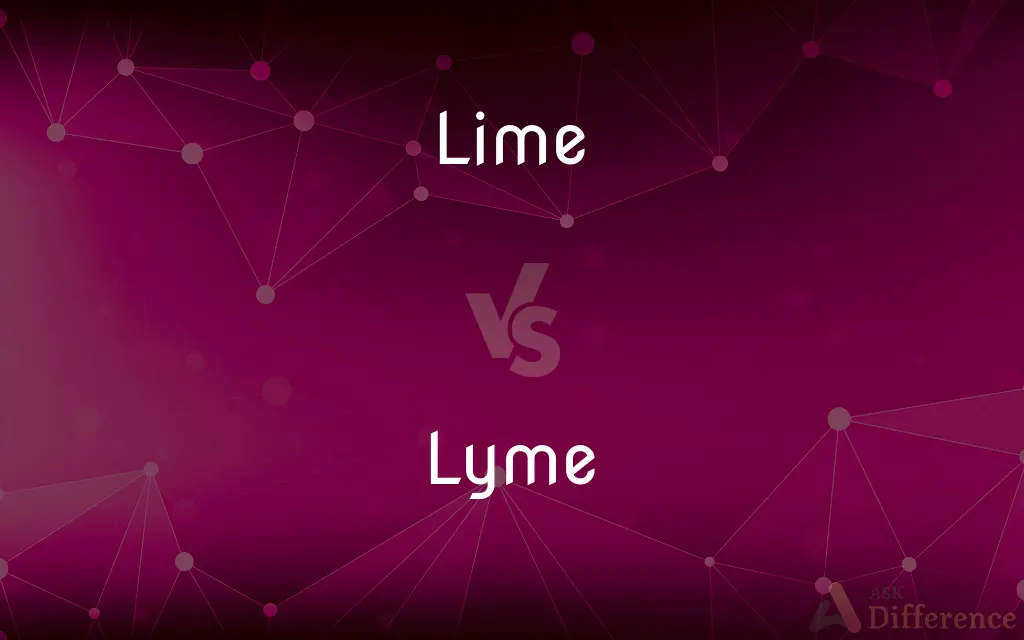Lime vs. Lyme — What's the Difference?
Edited by Tayyaba Rehman — By Fiza Rafique — Updated on November 2, 2023
Lime is a citrus fruit or a calcium-containing inorganic material, while Lyme refers to Lyme disease, a tick-borne illness.

Difference Between Lime and Lyme
Table of Contents
ADVERTISEMENT
Key Differences
Lime is a green citrus fruit known for its acidic juice; Lyme is a disease named after Lyme, Connecticut.
Lime in construction refers to a binding material, while Lyme disease is a health concern transmitted by ticks.
Limes add flavor to dishes and drinks; Lyme disease can cause flu-like symptoms and require medical treatment.
Gardeners use lime to alter soil pH; Lyme disease awareness focuses on prevention and prompt treatment.
Lime is commonly found in grocery stores; Lyme disease is diagnosed through medical tests.
ADVERTISEMENT
Comparison Chart
Category
Fruit/Chemical compound
Disease
Definition
A citrus fruit or calcium material
A tick-borne illness
Use
Culinary, construction
Medical context
Origin of the Term
Derived from Arabic "limah" or Latin "calx"
Named after Lyme, Connecticut
Associated with
Food, soil treatment
Health, ticks
Compare with Definitions
Lime
Soil amendment.
Lime was spread over the garden to reduce acidity.
Lyme
Disease.
Lyme disease is transmitted by tick bites.
Lime
Color.
He painted the room a bright shade of lime.
Lyme
Health concern.
Hikers in tick-infested areas are at risk for Lyme.
Lime
A white caustic alkaline substance consisting of calcium oxide, which is obtained by heating limestone and which combines with water with the production of much heat; quicklime.
Lyme
Geographic.
Lyme disease was named after the town of Lyme, Connecticut.
Lime
Birdlime.
Lyme
Medical condition.
Early symptoms of Lyme include fever and rash.
Lime
A rounded citrus fruit similar to a lemon but greener, smaller, and with a distinctive acid flavour
Wedges of lime
Lime juice
Roughly chop two limes
Lyme
Diagnostic.
Antibody tests can confirm a Lyme infection.
Lime
The evergreen citrus tree which produces limes, widely cultivated in warm climates.
Lyme
To hang out to spend time doing nothing in particular
Lime
A bright light green colour like that of a lime
A lime-green bikini
Lime
A deciduous tree with heart-shaped leaves and fragrant yellowish blossom, native to north temperate regions. The pale timber is used for carving and inexpensive furniture.
Lime
An informal social gathering characterized by semi-ritualized talking.
Lime
Treat (soil or water) with lime to reduce acidity and improve fertility or oxygen levels
They were liming acidified lakes
Lime
Catch (a bird) with birdlime
The bird that hath been limed in a bush
Lime
Sit or stand around talking with others
Boys and girls were liming along the roadside as if they didn't have anything to do
Lime
Any of several evergreen trees or shrubs of the genus Citrus having edible green or greenish-yellow fruit, especially the Mexican lime and the Persian lime.
Lime
The fruit of any of these plants, having a pulpy interior and usually acid juice.
Lime
See linden.
Lime
See calcium oxide.
Lime
Any of various mineral and industrial forms of calcium oxide differing chiefly in water content and percentage of constituents such as magnesia, silica, alumina, and iron.
Lime
Birdlime.
Lime
To treat with lime.
Lime
To smear with birdlime.
Lime
To catch or snare with or as if with birdlime.
Lime
(chemistry) Any inorganic material containing calcium, usually calcium oxide (quicklime) or calcium hydroxide (slaked lime).
Lime
(poetic) Any gluey or adhesive substance; something which traps or captures someone; sometimes a synonym for birdlime.
Lime
(theatre) A spotlight.
Lime
A deciduous tree of the genus Tilia, especially Tilia × europaea; the linden tree.
Lime
The wood of this tree.
Lime
Any of several green citrus fruit, somewhat smaller and sharper-tasting than a lemon.
Lime
Any of the trees that bear limes, especially Key lime, Citrus aurantiifolia.
Lime
(uncountable) A brilliant, sometimes yellowish, green colour associated with the fruits of a lime tree.
Lime
(fandom) A fan fiction story which contains sexual references, but stops short of full, explicit descriptions of sexual activity (coined by analogy with lemon).
Lime
A casual gathering to socialize.
Lime
(transitive) To treat with calcium hydroxide or calcium oxide (lime).
Lime
(transitive) To smear with birdlime.
Lime
(rare) To ensnare, catch, entrap.
Lime
(transitive) To apply limewash.
Lime
To hang out/socialize in an informal, relaxed environment, especially with friends, for example at a party or on the beach.
Lime
Containing lime or lime juice.
Lime
Having the aroma or flavor of lime.
Lime
Lime-green.
Lime
A thong by which a dog is led; a leash.
Lime
The linden tree. See Linden.
Lime
The fruit of the Citrus aurantifolia, allied to the lemon, but greener in color; also, the tree which bears it.
Lime
The color of the lime{1}, a yellowish-green.
Lime
Birdlime.
Like the limeThat foolish birds are caught with.
Lime
Oxide of calcium, CaO; the white or gray, caustic substance, usually called quicklime, obtained by calcining limestone or shells, the heat driving off carbon dioxide and leaving lime. It develops great heat when treated with water, forming slaked lime, and is an essential ingredient of cement, plastering, mortar, etc.
Lime
To smear with a viscous substance, as birdlime.
These twigs, in time, will come to be limed.
Lime
To entangle; to insnare.
We had limed ourselvesWith open eyes, and we must take the chance.
Lime
To treat with lime, or oxide or hydrate of calcium; to manure with lime; as, to lime hides for removing the hair; to lime sails in order to whiten them; to lime the lawn to decrease acidity of the soil.
Land may be improved by draining, marling, and liming.
Lime
To cement.
Lime
Having a yellowish-green color like that of the lime (the fruit).
Lime
A caustic substance produced by heating limestone
Lime
A white crystalline oxide used in the production of calcium hydroxide
Lime
A sticky adhesive that is smeared on small branches to capture small birds
Lime
Any of various related trees bearing limes
Lime
Any of various deciduous trees of the genus Tilia with heart-shaped leaves and drooping cymose clusters of yellowish often fragrant flowers; several yield valuable timber
Lime
The green acidic fruit of any of various lime trees
Lime
Spread birdlime on branches to catch birds
Lime
Cover with lime so as to induce growth;
Lime the lawn
Lime
Fruit.
She garnished her drink with a slice of lime.
Lime
Material.
The mason added lime to the mortar.
Lime
Chemistry.
Lime reacts with acid to produce a neutralizing effect.
Common Curiosities
What is lime?
Lime is a citrus fruit or a calcium-rich mineral used in various industries.
What are the uses of lime?
Lime is used in cooking, soil pH adjustment, and as a construction material.
What is Lyme?
Lyme refers to Lyme disease, an infectious disease caused by Borrelia bacteria.
How do you get Lyme disease?
Lyme disease is primarily transmitted through the bites of infected ticks.
Can Lyme disease be cured?
Yes, Lyme disease can often be successfully treated with antibiotics.
Is lime acidic or alkaline?
Lime is acidic when fresh, but lime in a chemical form can be alkaline.
Does lime come in varieties?
Yes, there are several varieties of lime, including Key lime and Persian lime.
Is Lyme disease contagious?
No, it cannot be transmitted from person to person.
Can lime juice be used as a cleaning agent?
Yes, lime juice has natural acidity that can disinfect and remove stains.
How is Lyme disease diagnosed?
It's diagnosed through symptoms, history of tick exposure, and sometimes blood tests.
What are the symptoms of Lyme disease?
Symptoms include rash, fever, fatigue, and joint pain.
Are there long-term effects of Lyme disease?
If untreated, it can lead to chronic symptoms like arthritis and neurological problems.
What precautions can prevent Lyme disease?
Using tick repellents, wearing protective clothing, and checking for ticks after outdoor activities.
Is it safe to consume a lot of limes?
In moderation, yes, but excessive amounts can lead to stomach upset due to acidity.
Can lime be added to all types of soil?
Not all; it should not be used in alkaline soils and is best used based on a soil test.
Share Your Discovery

Previous Comparison
Fuzzle vs. Muzzle
Next Comparison
Echidna vs. PangolinAuthor Spotlight
Written by
Fiza RafiqueFiza Rafique is a skilled content writer at AskDifference.com, where she meticulously refines and enhances written pieces. Drawing from her vast editorial expertise, Fiza ensures clarity, accuracy, and precision in every article. Passionate about language, she continually seeks to elevate the quality of content for readers worldwide.
Edited by
Tayyaba RehmanTayyaba Rehman is a distinguished writer, currently serving as a primary contributor to askdifference.com. As a researcher in semantics and etymology, Tayyaba's passion for the complexity of languages and their distinctions has found a perfect home on the platform. Tayyaba delves into the intricacies of language, distinguishing between commonly confused words and phrases, thereby providing clarity for readers worldwide.















































